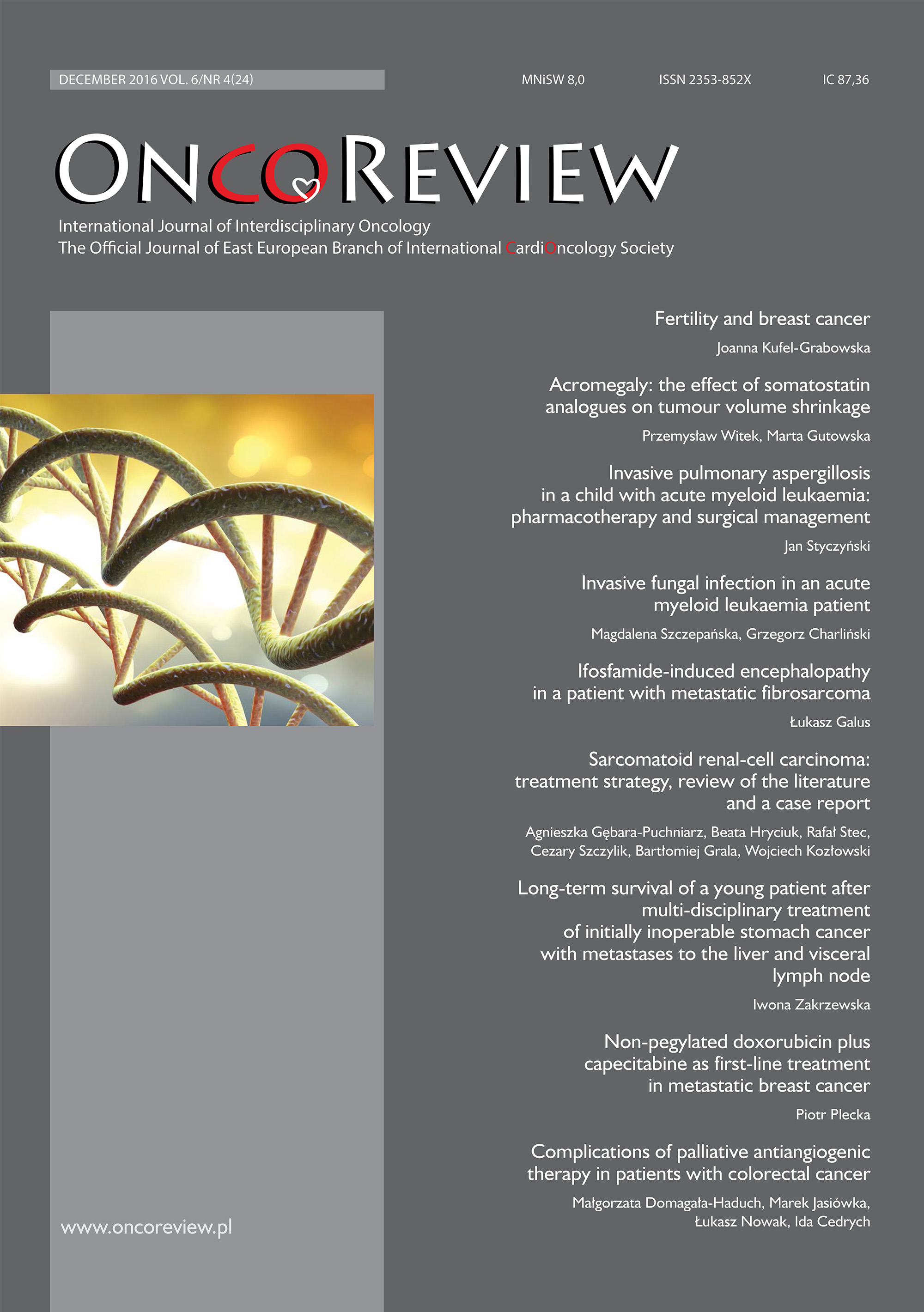Ifosfamide-induced encephalopathy in a patient with metastatic fibrosarcoma Case report
Main Article Content
Abstract
Ifosfamide is a cytostatic drug commonly used in chemotherapy. One of the common adverse effects resulting from the treatment with ifosfamide is encephalopathy. This paper describes a case study of a 64-year-old patient who suffered from a full-blown encephalopathy as a result of chemotherapy administered during the treatment of fibrosarcoma of the femur. It provides a hypothesis of the mechanism behind toxic effects of ifosfamide on the central nervous system and elaborates on a number of documented ways of preventing aforementioned complications.
Downloads
Metrics
Article Details

This work is licensed under a Creative Commons Attribution-NonCommercial 4.0 International License.
Copyright: © Medical Education sp. z o.o. This is an Open Access article distributed under the terms of the Attribution-NonCommercial 4.0 International (CC BY-NC 4.0). License (https://creativecommons.org/licenses/by-nc/4.0/), allowing third parties to copy and redistribute the material in any medium or format and to remix, transform, and build upon the material, provided the original work is properly cited and states its license.
Address reprint requests to: Medical Education, Marcin Kuźma (marcin.kuzma@mededu.pl)
References
2. Pelgrims J, De Vos F, Van den Brande J et al. Methyline blue in the treatment and prevention of ifosfamide induced encephalopathy: raport of 12 cases and review of literature. Br J Cancer 2000; 82(2): 291-294.
3. Curtin JP, Koonings PP, Gutierrez M et al. Ifosfamide-induced neurotoxicity. Gynecol Oncol 1991; 42(3): 192-193.
4. DiMaggio JR, Brown R, Baile WF et al. Hallucinations and ifosfamide-induced neurotoxicity. Cancer 1994; 73(5): 1509-1514.
5. Küpfer A, Aeschlimann C, Cerny T. Methylene blue and the neurotoxic mechanisms of ifosfamide encephalopathy. Eur J Clin Pharmacol 1996; 50(4): 249-252.
6. Kurowski V, Cerny T, Küpfer A et al. Metabolism and pharmacokinetics of oral and intravenous ifosfamide. J Cancer Res Clin Oncol 1991; 117(supl. 4): S148-S153.
7. Aeschlimann C, Küpfer A, Schefer H et al. Comparative pharmacokinetics of oral and intravenous ifosfamide/mesna/methylene blue therapy. Drug Metab Dispos 1998; 26(9): 883-890.
8. Malhotra A, Poiesz BJ, Burgdorf AW et al. Ifosfamide Induced Neurotoxicity Secondary to Concomitant Aprepitant Use. Adv Pharmacoepidem Drug Safety 2012; 1: 3 http://dpi.org/10.4172/2167-1052.1000114.
9. Kaijser GP, Beijnen JH, Bult A et al. Ifosfamide metabolism and pharmacokinetics (review). Anticancer Res 1994; 14: 517-531.
10. Sweiss K, Beri R, Shord SS. Encephalopathy after high-dose Ifosfamide: a retrospective cohort study and review of the literature. Drug Saf 2008; 31(11): 989-996.
11. Lo Y, Shen LJ, Chen WH et al. Risk factors of ifosfamide-related encephalopathy in adult patient with cancer: A retrospective analysis. J Formos Med Assoc 2015; 115(9): 744-751. http://dx.doi.org/10.1016/j.jfma.2015.07.016.
12. Szabatura A, Cirrone F, Harris C et al. An assessment of risk factors associated with ifosfamide-induced encephalopathy in large academic cancer center. J Oncol Pharm Pract 2015; 21(3): 188-193.
13. Küpfer A, Aeschlimann C, Wermuth B et al. Prophylaxis and reversal of ifosfamide encephalopathy with methylene-blue. Lancet 1994; 343(8900): 763-764.
14. Koschuth A, Spath-Schwalbe E, Possinger K. Methylenblau bei Ifosfamid-induzirerter Enzephalopathie. Dtsch Med Wochenschr 1996; 121: 1210.
15. Imtiaz S, Muzaffar N. Ifosfamide neurotoxicty in young female with remarkable response to Thiamine. J Pak Med Assoc 2010; 60(10): 867-869.
16. Buesa JM, Garcia-Teijido P, Losa R et al. Treatment of ifosfamide encephalopathy with intravenous thiamin. Clin Cancer Res 2003; 9(12): 4636-4637.

